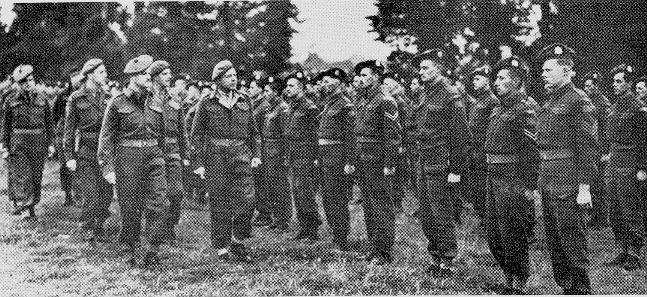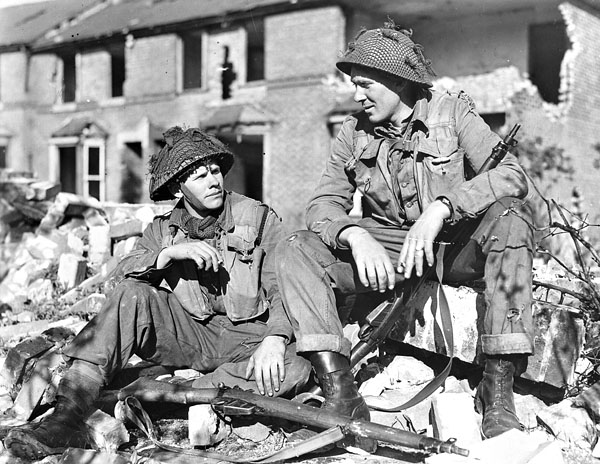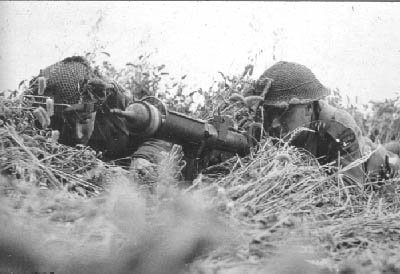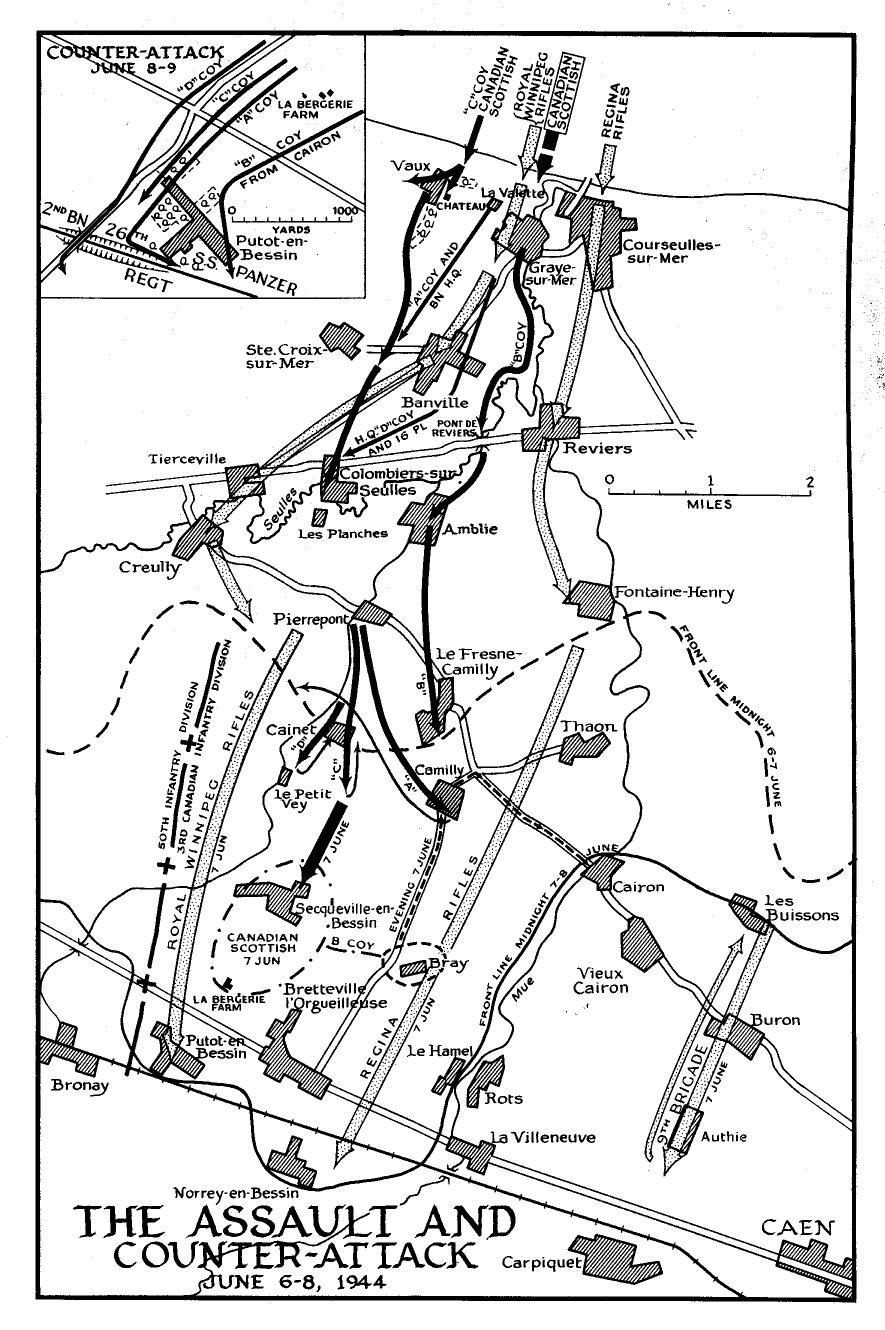

The Canadian Scottish Regiment was from Victoria, British Columbia. For the initial D-Day assault, 'C' Company of the Canadian Scottish was attached to the Royal Winnipeg Rifles to extend the right flank and knock out a 75mm gun emplacement three quarters of a mile west of Courseulles.
'C' Company commanded by Major D.G. Crofton, landed at about 0750 hours and came under machine gun fire and mortar fire as they raced across the 75 - 100 yards of beach. They found their targeted pillbox already demolished by the naval bombardment. They moved onto their second objective, the Chateau Vaux. The Scottish stormed the Chateau and tossed several hand grenades inside. A group of dispirited Germans quickly surrendered.

Canadian Scottish
Lieut. Schjelderup's platoon, followed by company headquarters, pressed forward along the centre, up the road to Vaux and then through the tree-filled gulley towards the open fields beyond. Then the platoon attacked three machine gun posts, one after another. It was grim going, but not a man faltered. The platoon took about fifteen prisoners, one of whom led the assault troops through a heavily mined area in the gulley. Once through the minefield, the platoon started out across the fields in extended formation, moving through the tall grain towards the gap between Ste.Croix-sur-Mer and Banville. The other platoons came up on the flanks, closing up on either side of company headquarters towards the tip of the woods.
The remaining Can Scots companies came ashore shortly before 0900 under sporadic mortar fire. The beach exits were not complete and there was scattered resistance behind the beaches. It took the Can Scotts one hour to clear and move past the beach. 'B' Company, commanded by Major R.M. Lendrum, struck inland across the fields between La Velette and Graye-sur-Mer, along the low ground bordering the river Seulles towards Amblie. 'A' Company, 'D' Company and Battalion Headquarters assembled at La Valette before moving inland.
A German 88-mm gun camouflaged in a hay stack, began firing and destroying vehicles as they moved off the beach. Major Plows commanding officer for 'A' Company ordered Lieutenant Bernie Clarke's platoon to take out the dangerous gun emplacement. Clarke's classic reply was "Who? Me?", and he immediately set out to clear up the spot. They crawled up a knoll to within 75 yards of the position, nabbed several Germans, and then raced in. It turned out to be a gun emplacement encased in concrete with hay piled on its roof for camouflage. A door leading into the emplacement was pulled open and someone threw in a grenade. That did the trick. So quick and sudden was the Canadian action that about fifty German soldiers came out of their slit trenches - all surrendering. It was at this point that 'A' Company's second in command, Captain William H.V. Matthews came running up, asking Clarke, "What the hell are you trying to do, win the VC?"

Captains Albert Johnson and Gordon, Canadian Scottish Regiment, taking part in a house-clearing training exercise, England, 22 April 1944 (LAC PA-162246).
The Vaux and Ste. Croix area was the headquarters for the German 726 Regiment's 2nd Battalion. The Winnipeg Rifles encountered strong opposition in Ste. Croix and the beachhead was in danger of being overrun by the Germans in this area. The Can Scots 'A' and 'C' Companies were sent to support the Winnipeg Rifles in Ste.Croix-sur-Mer.
Lieut. Schjelderup: "An L.M.G. opened up from about 150 yards away. We hit the dirt…There was only one course of action and to a man the platoon rushed the enemy positions. It was a bitter encounter with much hand-to-hand fighting. Enemy supporting fire from the area on the northern outskirts of Ste. Croix and mortar fire from Ste. Croix made our task more difficult".
Artillery fire was brought down on the enemy positions, and with supporting tanks the Winnipegs took the task of stamping out the remaining resistance. The Can Scotts 'A' and 'C' Companies pushed forward towards Colombiers-sur-Seulles. 'D' Company commanded by Major G.T. MacEwan, moved one platoon each up to Pont de Reviers and Colombiers on the left, and ran into Germans exiting from Ste. Croix. Shooting up the retreating vehicles the Can Scots took many prisoners here.

Infantrymen with PIAT
'B' Company on the far left, found Amblie clear of the enemy and continued on across the open fields and up the slope overlooking the valley of the Mue River. About four-thirty in the afternoon, after crossing the river Seulles at Colombiers, Lieutenant-Colonel Fred Cabeldu, reported to Brigade Headquarters that the battalion had reached 'Elm', the code name for the Creully-Pierrepont road located more than four miles directly inland from the beaches.
'A' and 'D' companies passed through Pierrepont and moved to the front. Their progress was slowed as they fought through scattered mortar and machine gun positions and flushed out German stragglers along the way. 'A' Company marched towards Camilly and made contact with 'B' Company at Le Fresne-Camilly. At 17:15 they captured an artillery position of the 109 Artillery Regiment and then occupied the village of Camilly. 'D' Company swung to the right and took up positions in the Cainet - Le Petit Vey area. 'C' Company mounted an attack on an enemy mortar and machine gun position before taking the high ground 1,000 yards south of Cainet.

Canadian Scottish Assault and Counter-attack Map
By nightfall the Canadian Scottish were six miles inland, dug in their forward positions around Pierrepont and ready for an expected counter-attack. It was a remarkable achievement for the Can Scots, and said a great deal for the aggressive leadership of the officers as well as the splendid spirit of the men. There were many gaps in the ranks and no platoon had been hit harder than Lieutenant Schjelderup's. He had come ashore with forty-five men under his command but by the end of the day there were only nineteen men left and he himself was ordered back to have his wounds dressed. On D-day the Canadian Scottish had a total of 87 casualties, but had inflicted heavy losses on the enemy and taken about 200 prisoners.
